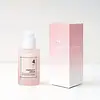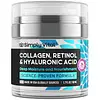What's inside
What's inside
 Key Ingredients
Key Ingredients

 Benefits
Benefits

 Concerns
Concerns

 Ingredients Side-by-side
Ingredients Side-by-side

Collagen Extract 73%
Skin ConditioningButylene Glycol
HumectantWater
Skin Conditioning1,2-Hexanediol
Skin ConditioningGlycerin
HumectantGlycereth-26
HumectantNiacinamide
SmoothingPEG-240/Hdi Copolymer Bis-Decyltetradeceth-20 Ether
StabilisingCaprylic/Capric Triglyceride
MaskingMethylpropanediol
SolventPolyglyceryl-3 Methylglucose Distearate
EmulsifyingHydroxyethyl Urea
HumectantCellulose Gum
Emulsion StabilisingDicaprylyl Ether
EmollientCaprylyl Methicone
Skin ConditioningGlyceryl Polymethacrylate
Glyceryl Stearate
EmollientRose Extract
Skin ConditioningWine Extract
AntioxidantSucrose
HumectantAdenosine
Skin ConditioningDisodium EDTA
Mineral Salts
Skin ConditioningSodium Hyaluronate
HumectantPotassium Laurate
EmulsifyingTocopherol
AntioxidantPotassium Hyaluronate
Skin ConditioningEthylhexylglycerin
Skin ConditioningHydrolyzed Elastin
EmollientHydrolyzed Keratin
HumectantHydrolyzed Silk
HumectantHyaluronic Acid
HumectantHydrolyzed Hyaluronic Acid
HumectantSodium Acetylated Hyaluronate
HumectantHydroxypropyltrimonium Hyaluronate
Sodium Hyaluronate Crosspolymer
HumectantDimethylsilanol Hyaluronate
HumectantCaprylyl Glycol
EmollientHydrogenated Lecithin
EmulsifyingSodium Phosphate
BufferingPalmitoyl Tripeptide-5
Skin ConditioningAcetyl Hexapeptide-8
HumectantOligopeptide-3
Skin ConditioningParfum
MaskingCollagen Extract 73%, Butylene Glycol, Water, 1,2-Hexanediol, Glycerin, Glycereth-26, Niacinamide, PEG-240/Hdi Copolymer Bis-Decyltetradeceth-20 Ether, Caprylic/Capric Triglyceride, Methylpropanediol, Polyglyceryl-3 Methylglucose Distearate, Hydroxyethyl Urea, Cellulose Gum, Dicaprylyl Ether, Caprylyl Methicone, Glyceryl Polymethacrylate, Glyceryl Stearate, Rose Extract, Wine Extract, Sucrose, Adenosine, Disodium EDTA, Mineral Salts, Sodium Hyaluronate, Potassium Laurate, Tocopherol, Potassium Hyaluronate, Ethylhexylglycerin, Hydrolyzed Elastin, Hydrolyzed Keratin, Hydrolyzed Silk, Hyaluronic Acid, Hydrolyzed Hyaluronic Acid, Sodium Acetylated Hyaluronate, Hydroxypropyltrimonium Hyaluronate, Sodium Hyaluronate Crosspolymer, Dimethylsilanol Hyaluronate, Caprylyl Glycol, Hydrogenated Lecithin, Sodium Phosphate, Palmitoyl Tripeptide-5, Acetyl Hexapeptide-8, Oligopeptide-3, Parfum
Water
Skin ConditioningCaprylic/Capric Triglyceride
MaskingCocos Nucifera Oil
MaskingSimmondsia Chinensis Seed Oil
EmollientAloe Barbadensis Leaf Juice
Skin ConditioningStearyl Alcohol
EmollientStearic Acid
CleansingIsopropyl Myristate
EmollientRetinol
Skin ConditioningHydrolyzed Collagen
EmollientHyaluronic Acid
HumectantAcrylates/Steareth-20 Methacrylate Copolymer
Phenoxyethanol
PreservativeCaprylyl Glycol
EmollientPotassium Sorbate
PreservativeImidazolidinyl Urea
PreservativeEDTA
Carbomer
Emulsion StabilisingPersea Gratissima Oil
Skin ConditioningChamomilla Recutita Flower Extract
MaskingTocopheryl Acetate
AntioxidantWater, Caprylic/Capric Triglyceride, Cocos Nucifera Oil, Simmondsia Chinensis Seed Oil, Aloe Barbadensis Leaf Juice, Stearyl Alcohol, Stearic Acid, Isopropyl Myristate, Retinol, Hydrolyzed Collagen, Hyaluronic Acid, Acrylates/Steareth-20 Methacrylate Copolymer, Phenoxyethanol, Caprylyl Glycol, Potassium Sorbate, Imidazolidinyl Urea, EDTA, Carbomer, Persea Gratissima Oil, Chamomilla Recutita Flower Extract, Tocopheryl Acetate
Ingredients Explained
These ingredients are found in both products.
Ingredients higher up in an ingredient list are typically present in a larger amount.
This ingredient is an emollient, solvent, and texture enhancer. It is considered a skin-softener by helping the skin prevent moisture loss.
It helps thicken a product's formula and makes it easier to spread by dissolving clumping compounds.
Caprylic Triglyceride is made by combining glycerin with coconut oil, forming a clear liquid.
While there is an assumption Caprylic Triglyceride can clog pores due to it being derived from coconut oil, there is no research supporting this.
Learn more about Caprylic/Capric TriglycerideCaprylyl Glycol is a humectant and emollient, meaning it attracts and preserves moisture.
It is a common ingredient in many products, especially those designed to hydrate skin. The primary benefits are retaining moisture, skin softening, and promoting a healthy skin barrier.
Though Caprylyl Glycol is an alcohol derived from fatty acids, it is not the kind that can dry out skin.
This ingredient is also used as a preservative to extend the life of products. It has slight antimicrobial properties.
Learn more about Caprylyl GlycolHyaluronic acid is naturally found in healthy skin. It is a humectant, meaning it draws moisture to your skin.
This ingredient helps hydrate, soothe, and protect the skin.
What makes hyaluronic acid so hydrating? It has the capacity to bind or hold large amounts of water.
Fun fact: It is already naturally found in our bodies, such as the fluids of our eyes and our joints.
Studies find this ingredient to have anti-inflammatory and anti-microbial properties. This can help speed up wound-healing.
Hyaluronic acid can be irritating if the molecule has a low-molecular weight, or if the molecules are small.
One study found low-molecular weight hyaluronic acid to be pro-inflammatory, meaning some people may experience irritation. This is because our bodies use hyaluronic acid in the wound-healing process to signal to our bodies, via irritation, that something needs healing.
The same study found high-molecular weight hyaluronic acid to be anti-inflammatory.
These are some other common types of Hyaluronic Acid:
Learn more about Hyaluronic AcidWater. It's the most common cosmetic ingredient of all. You'll usually see it at the top of ingredient lists, meaning that it makes up the largest part of the product.
So why is it so popular? Water most often acts as a solvent - this means that it helps dissolve other ingredients into the formulation.
You'll also recognize water as that liquid we all need to stay alive. If you see this, drink a glass of water. Stay hydrated!
Learn more about Water